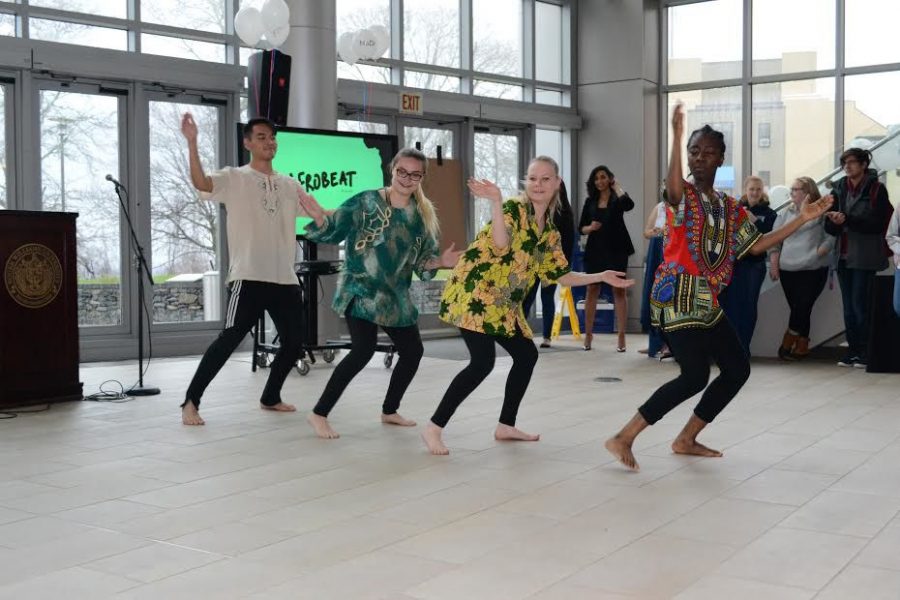Social justice zine “NaDI” launches: Digital publication features “New and Dangerous Ideas”
Social justice issues may not always seem like they are on the forefront of all students minds’ at RWU, but the Intercultural Center’s Zine Team seeks to change that with the release of its new publication. Entitled “NaDI,” the online magazine calls attention to social justice issues that students and members of the wider society face on a daily basis.
The Zine Team advisors are Associate Director of the Intercultural Center, MiNa Chung, and Coordinator of Residence Education in Willow Hall, Rach Pozerski. Student team members include seniors Maria Caceres, marcomm director, Creative Director Hala Wikidi, Managing Copy Editor Lily Schenk, and sophomore Executive Secretary Edmund Geschickter. The advisors meet with the group weekly to review what they have been working on, but decisions ultimately land on the students, making NaDI a mostly student run publication.
NaDI is meant to be an acronym for “New and Dangerous Ideas.” It correlates with the university’s historical namesake, as Roger Williams himself was found guilty of spreading new and dangerous ideas in the Massachusetts Bay Colony in the 1600s. Geschickter acknowledged that the team felt it was appropriate to honor that and try to bring light to the concept in the modern age.
Developing NaDI as a whole requires an immense amount of hard work and dedication, from students and faculty alike. The team began working on the zine at the beginning of last semester and worked the entire school year to produce it. A nine member faculty selection committee was also involved in the development process, as they played a major role in selecting which art pieces, out of over 70 submissions, would go into the zine.
There were certain obstacles that the team had to overcome in the process of building the zine, mainly including getting the word out to students and helping them to understand NaDI’s purpose. Caceres said that students here have told her “they aren’t into social justice,” and she says it is important that people understand the meaning behind it. She clarifies that even if one does not comprehend the issues in their entirety, they are still very real problems.
“There is a system. Just because you are not affected by it, does not mean it doesn’t exist,” Caceres said.
NaDI launched on April 25 at 4 p.m. in the GHH Atrium. The launch party had a successful turnout, as many students and other faculty members came to observe the the captivating pieces. Chung addressed the crowd first, as she explained her passion for art and social justice along with the immense amount of respect and admiration she has for the students on her team.
“I attribute the success of NaDI solely, and I mean solely, to my dedicated and passionate interns,” Chung said. “I am moved in such deep ways when thinking about how the success of NaDI was not just about its outcome, but about the team that honored each other every step of the way.”
The launch featured two live performances from students whose pieces are included in the zine. One of these was a performance of “Afrobeat Dance,” featuring sophomore Elfreda Hoff, sophomore Emily Gravino, junior Samantha Peck Dionne, and senior Virakchey Chung. The story behind this routine derives from Hoff’s childhood experiences in Ghana. Before moving to the U.S., her parents got her involved in an African dance group. She said that’s when dance really started for her, and she loves being able to show people her work.
There were so many different art forms on display at the launch, including paintings, poems, and even a quilt. Sarah Slowik, the quilt’s creator, made the piece for her mixed media class last semester when exploring the themes surrounding femininity. Some of the squares feature intricate embroideries of body parts and poses. She knew right away that she wanted to submit it to NaDI.
“As soon as I read the statement of what they were looking for, I immediately thought that the theme of this quilt would work perfectly,” Slowik said.
Students simply could not pick a favorite piece out of the exhibition. Every work was valuable for different reasons, as onlookers acknowledged.
“Each piece is both beautiful and powerful in its own way,” Geschickter said. “Different pieces will stand out to different people, so it really depends on who you are individually.”
Geschickter said that NaDI will follow the same publication pattern next year, with one issue at the end of the Spring semester. However, his and MiNa’s long term goal is to turn the operation into a once-a-semester publication.
The zine may be organized and published by a team of four, but all students are encouraged to get involved with NaDI by submitting any form of art that they have created which relates to social justice. The team considers almost everything that is a form of expression art, and loves to see submissions from students who are passionate about their work.







